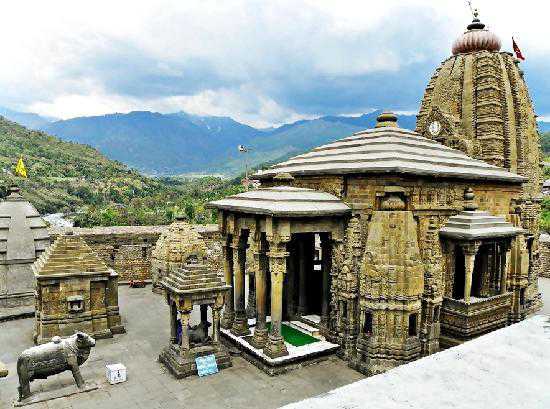Nestled in the serene lap of the Himalayas, where the mighty mountains seem to touch the heavens, lies the Baijnath Temple. This ancient shrine, wrapped in the tranquility of nature, stands as a testament to faith, history, and the enduring allure of spirituality. Join me on this enchanting journey as we unravel the beauty and significance of the Baijnath Temple, along with the captivating legend that weaves its mystical tapestry.
Location
The Baijnath Temple is situated in the town of Baijnath, in the Kangra district of Himachal Pradesh, India. Perched along the banks of the glistening River Beas, the temple is embraced by the majestic Dhauladhar Range. This divine abode is approximately 50 kilometers from Dharamshala and just 17 km from the beautiful town of Palampur, offering pilgrims and travelers a tranquil retreat amidst nature’s splendor.
The History
The history of the Baijnath Temple is enigmatic, shrouded in legends that have been passed down through generations like cherished heirlooms. Baijnath is renowned for the Baijnath Temple, which is dedicated to Lord Shiva and is considered one of the twelve Jyotirlingas (sacred abodes of Lord Shiva)
The legend traces back to the era of the famous Pandava brothers from the epic Mahabharata. As the story goes, King Ravana, the powerful demon king of Lanka and a devoted disciple of Lord Shiva, performed rigorous penance to please his deity. Pleased with Ravana’s devotion, Lord Shiva is believed to have granted him a divine lingam (a symbol of the deity).
This lingam, a revered embodiment of Lord Shiva, was enshrined in the Baijnath Temple, where it has stood for centuries. The temple is dedicated to Lord Vaidyanath, an aspect of Lord Shiva known as the “Lord of Physicians,” making it a place of healing and divine intervention.
Another legend associated with Baijnath Temple tells the story of a serpent that used to offer milk to the lingam daily. Upon discovering this, a Brahmin cut off the serpent’s head. Miraculously, the serpent’s head grew back, signifying the temple’s sanctity.
An interesting fact about the town Baijnath, where Baijnath Temple is located, is that this Himachal town does not celebrate Dussehra. There are several intriguing legends associated with the Baijnath Temple, but one particular story stands out due to its fame. According to this legend, Ravana, the demon king of Lanka, was a devoted worshipper of Lord Shiva. In his quest for invincible powers, Ravana decided to conduct an elaborate worship ceremony for Lord Shiva at Mount Kailash. To express his dedication, he offered all ten of his heads in the sacred fire (havan kund) as a gesture of devotion and penance, hoping to please Shiva.
Impressed by Ravana’s unwavering devotion, Lord Shiva granted him the blessings of invincibility and immortality. Soon after obtaining his desired boons, Ravana requested Lord Shiva to accompany him to Lanka. In response, Lord Shiva transformed himself into a shiva linga and asked Ravana to carry this divine representation to Lanka. However, Shiva issued a solemn warning to Ravana not to place the shiva linga on the ground during his journey. It was stipulated that if, for any reason, the shiva linga was set down, Lord Shiva would remain at that very location indefinitely.
Ravana agreed to the terms and commenced his journey carrying the sacred shiva linga. However, while traveling through Baijnath in Himachal Pradesh, he became thirsty and encountered a shepherd who, in actuality, was Lord Ganesha in disguise. Ravana requested a drink of water, and Lord Ganesha, in his guise as the shepherd, invoked the Lord of Water (Varuna) to fill a vessel with water and offer it to Ravana.
Having quenched his thirst, Ravana felt the need to relieve himself. He asked Lord Ganesha to hold the shiva linga briefly while he attended to his needs. Unfortunately, Lord Ganesha inadvertently placed the shiva linga on the ground, contravening the instructions given by Lord Shiva. As a result, the shiva linga became firmly established at that very spot in the form of Ardhanarishwar, where Lord Shiva is depicted as half-male and half-female. This significant event took place in the present-day town of Baijnath.
As a mark of respect for Ravana’s unwavering devotion to Lord Shiva and the unique story associated with Baijnath, the town does not celebrate Dussehra in the traditional manner. While many parts of the country burn effigies of Ravana and his clan during Dussehra, Baijnath refrains from this ritual, recognizing Ravana’s devotion and Lord Shiva’s divine presence in their town.
About The Temple
The Baijnath Temple is a masterpiece of ancient North Indian architecture, boasting intricate carvings and an elegant design that reflects the region’s rich cultural heritage. The temple’s sanctum sanctorum houses the revered lingam of Lord Vaidyanath, the object of worship for countless devotees.
The temple complex is enveloped by lush gardens and soothing natural surroundings, creating a sense of serenity and spiritual harmony. It’s a place where the sacred and the scenic seamlessly merge.
Spiritual Significance
For devout pilgrims, the Baijnath Temple holds profound spiritual significance. It is believed that seeking the blessings of Lord Vaidyanath can alleviate physical ailments and grant spiritual solace. The temple is also a destination for those embarking on the Char Dham Yatra pilgrimage circuit.
A visit to the Baijnath Temple is not just a journey to a religious site; it is an immersion into the rich tapestry of legends and the timeless allure of divine grace. Surrounded by the Himalayan grandeur and the melodious flow of the River Beas, the temple stands as a symbol of faith and healing. Whether you seek physical well-being or spiritual awakening, the Baijnath Temple promises an experience that resonates deeply with the soul, leaving you with a sense of awe and reverence for the mysteries of the divine.

